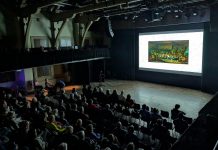
Peterborough’s new waterfront Canadian Canoe Museum has received even more national recognition, along with the local architectural firm responsible for the museum’s design.
The museum has been featured on the cover of April’s Canadian Architect, one of the most respected design publications in the country, with the magazine also recognizing the work of Peterborough-based Unity Design Studio (formerly Lett Architects Inc.).
Construction of the new facility began in late 2021, but faced delays due to the impact of the pandemic on the construction industry, including supply chains and material and labour shortages. The museum opened its doors two-and-a-half years later, in May 2024.
“On the Canadian Canoe Museum project, Unity faced a challenging set of conditions: a constrained budget, a site different than the one they had initially designed for, and a compressed timeframe for construction,” writes Javier Zeller, an architect working in Toronto with Diamond Schmitt Architects, in the Canadian Architect story.
“Unity nonetheless delivered a much better building than would have been expected in the circumstances they faced. With a restrained palette of materials and controlled spatial sequence, Unity Architects has created a place that connects the visitor to the artifacts through material and movement.”
Designed to reflect the form and spirit of the canoe, the two-storey 65,000-square-foot building features mass timber construction and a warm, natural palette that connects visitors to the surrounding land and water. A 17,000-square-foot exhibition hall anchors the experience, alongside spaces for learning, programming, and community engagement.

“We knew from the beginning this had to be more than just a place to display canoes,” says Unity design principal Michael Gallant in a media release. “It needed to reflect their meaning-connection, movement, storytelling — and invite people to experience those values firsthand.”
“Constraints like a tight site and floodplain restrictions didn’t limit the design — they focused it. They pushed us to think vertically, to create a procession, and to use every inch of the building to celebrate the canoe and its connection to water.”
Unity Design Studio has a longstanding relationship with the Canadian Canoe Museum, the release states, adding “designing its new home has been a true honour.”
For the design and building of the new facility, The Canadian Canoe Museum took an integrated project delivery (IPD) approach.
Unlike traditional design and construction delivery methods, IPD is a collaborative approach where all project stakeholders are brought on board at the very beginning of the project, sign a multi-party contract, and share the responsibility for the project — including the financial risk.
“From site selection to construction, we were walking the path with the client, not just for them,” says Unity managing principal Bill Lett. “That level of trust and shared purpose shaped every decision and brought out the best in everyone involved. With trades, architects, and clients all in one room, ideas flowed, egos took a back seat, and solutions came from every corner of the team. Integrated project delivery wasn’t just a method, it was a mindset.”
The Canadian Architect coverage is only the latest recognition of The Canadian Canoe Museum. In March, the museum was named in TIME magazine’s list of the world’s greatest places to visit in 2025 — and the only Canadian destination on the list.
That recognition came just two months after the museum was mentioned in a similar list published by the New York Times, and a year after the museum was named one of the Best Cultural Spots on National Geographic’s Best of the World list.


























